What Makes the MSR® Evo™ Snowshoe the Best Snowshoe?
You may not think about it when you strap your foot to a pair of brand new MSR Evo Snowshoes, but you’re stepping into a legendary technology that changed snowshoeing forever. And sure – lots of companies say stuff like that about everything from razors to garden widgets, but like so many MSR innovations over the years, there’s no hyperbole in calling the world’s first solid platform snowshoe a legit game changer.

The History
Bill Forrest was a prolific climber, inventor and no stranger to bringing game-changing ideas to life. By the time Bill passed in 2012 at the age of 73 (while doing what he loved–snowshoeing) he had left us with major contributions to the evolution of rock and ice climbing equipment and a few really bad-ass climbing achievements, like being the first person to solo the Diamond on Colorado’s Long’s Peak in 1970, and a 2500-foot first ascent on the notoriously scary walls of the Black Canyon of the Gunnison.
In 1993, an illness on an attempt of Mt. Everest ended Bill’s climbing days, but he was now able to focus in his ideas for new gear. He brought one of them to MSR for help with development: a solid deck snowshoe made of a rugged plastic. By 1995, MSR was ready to introduce the Denali–the world’s first solid-deck snowshoe–and the impact was immediate. While some traditionalists bemoaned the idea of “plastic” snowshoes, when people actually got their hands on them, word began to spread about just how revolutionary they really were.

The Innovations
One of the most impressive things about the Denali snowshoes was their monumental leap in traction technology. Prior to the Denali, snowshoe frames were largely made from round tubes of metal, whose only traction came from a wrap of plastic or neoprene cord. Beyond that, they had a crampon to deliver traction underfoot, but the rest of the smooth, flat decking was anything but helpful. Traversing across a slope with a round tube being the first thing to contact the snow was–and remains–a pretty sketchy affair. This was the inspiration for the Denali’s groundbreaking UniBody™ traction, as it was now possible mold it right into the deck itself. This provided unmatched control and stopping and power, up and down slopes. In addition to aggressive crampon, toothed metal Traction Bars ran lengthwise on each edge of the snowshoe. Combined with the hard, flat edges of the deck itself, The Denali snowshoes became the new standard in control and security on traverses.
Another game-changer was the introduction of variable flotation. Thanks to the innovation of modular snowshoe tails, it was now possible for one size of snowshoe to handle a huge range of conditions. With traditional shoes, you had to choose the added agility of a smaller snowshoe, or the extra flotation of a larger shoe; it was an either/or dilemma. Adding 6 in. tails to the Denali snowshoes allowed you to get the best of both worlds on-demand, creating the most versatile snowshoe system to-date. And remember–all of this happened 25 years ago!
Finally, while not as immediately obvious as the giant gains in traction and versatility, these “plastic” snowshoes actually provided an incredible boost in durability as well. Metal tube frames routinely thin and wear out slowly near the toe where they take the brunt of each step’s impact, eventually snapping at some surely inconvenient time. The strapping that connects the deck material will also wear away, creating another set of unique problems, or weight-increasing solutions. Ironically, a solid deck, built with the right materials, will easily outlast a tube snowshoe by a large margin, with zero maintenance issues.

Today’s Evo Snowshoes
Evo Snowshoes remain one of our most popular snowshoes for many reasons, but those key innovations from 1995 remain at the core of it. Today’s Evo snowshoes are built with all of the learning from 25 years in the field, allowing us to evolve (EVO-lve…see what we did there?) every last component for optimal durability and performance.
Key updates include a more streamlined deck for easier walking and a far more secure three-point attachment system for the modular snowshoe tails. While the binding has always been built to MSR’s standards of field maintainability and easy adjustment, today’s bindings are built from the toughest, freeze-resistant materials we’ve found, and fit just about any shoe you could possibly wear–from trail runners to size 13 snowboard boots–all with a glove-friendly design that makes your time out just that much easier and safer.

Evo Ascent vs. Evo Trail?
While the aggressive, vertical 360° Traction™ frames of our most advanced snowshoes are the best bet for extensive time off-trail in the most challenging terrain, Evo snowshoes represent a tremendous value for everything from beginners on groomed trails, to moderate adventures in the backcountry.
The Evo Trail snowshoe is our easiest entry point to snowshoeing. It’s ideal for beginners who spend the majority of their time on packed or groomed trails over flat to moderate terrain. Their DuoFit™ bindings feature the same materials used in many of our best shoes, and two straps over the top keep getting in and out quick and easy, yet delivering ample control for moderate terrain.
The Evo Ascent snowshoe does everything the Evo Trail snowshoes does and includes a few great features that will make your time off-trail even better. First, the TriFit™ binding adds another strap over the top of your boot for added control and security on traverses and otherwise uneven terrain. And perhaps most important of all is the addition of the Televator™ heel lift. Deploy these handy lift bars under your heel on the steeps to neutralize slope angles and reduce fatigue–a real life-saver on long and/or steep uphill grinds.
If you’re new to snowshoeing this year, or just looking for the best snowshoe for easy to moderate conditions, it hard to beat the 25 years of evolution built into every pair of MSR’s Evo Snowshoes.
 Jim Meyers survives between road trips by pushing all the buttons at Vertizon Photography and is a recovering copywriter, turned freelance writer. He’s climbed, skied, backpacked, cycled and fly fished extensively throughout North America and is selfishly raising two budding adventurers with his wife and Type-2 fun soulmate in Seattle, WA.
Jim Meyers survives between road trips by pushing all the buttons at Vertizon Photography and is a recovering copywriter, turned freelance writer. He’s climbed, skied, backpacked, cycled and fly fished extensively throughout North America and is selfishly raising two budding adventurers with his wife and Type-2 fun soulmate in Seattle, WA.
